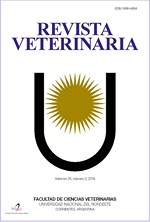Uso de fármacos en la hembra canina preñada
DOI:
https://doi.org/10.30972/vet.3416613Palabras clave:
Preñez, caninos, terapéutica, modificaciones fisiológicas, ADMEResumen
Los cambios fisiológicos en la preñez inducen alteraciones profundas en las propiedades farmacocinéticas de muchos medicamentos. Estos cambios afectan la absorción, la distribución, el metabolismo y la excreción de los fármacos y, por lo tanto, pueden afectar sus propiedades farmacodinámicas. Es necesario comprender tanto la fisiología de la preñez como la farmacología específica de los diferentes agentes para lograr un tratamiento eficaz y limitar el riesgo materno y fetal. Desafortunadamente, la mayoría de los estudios de medicamentos excluyen a las hembras preñadas, aún cuando existen entidades patológicas que requieren ser tratadas durante la preñez (dolor, procesos infecciosos, etc). Esta revisión se inicia con un recordatorio de los conceptos básicos de farmacocinética y su relevancia clínica. Se describen los cambios fisiológicos durante la preñez y sus consecuencias en las propiedades farmacocinéticas y farmacodinámicas de muchos medicamentos. Como cierre, se analizan de manera particular las categorías terapéuticas más comúnmente indicadas en hembras preñadas.Descargas
Descargas
Publicado
Cómo citar
Número
Sección
Licencia
Política de acceso abierto
Esta revista proporciona un acceso abierto inmediato a su contenido, basado en el principio de que ofrecer al público un acceso libre a las investigaciones ayuda a un mayor intercambio global de conocimiento. La publicación por parte de terceros será autorizada por Revista Veterinaria toda vez que se la reconozca debidamente y en forma explícita como lugar de publicación del original.
Esta obra está bajo una licencia de Creative Commons Reconocimiento-NoComercial 4.0 Internacional (CC BY-NC 4.0)










.jpg)
.jpg)



